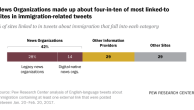A snapshot of the newspaper sports page
Overview
The sports sections of America’s newspapers are a passive and reactive space, one dominated by game previews and recaps with little room for enterprise reportage, a new study of the sports section fronts finds.
The definition of “sports” on the section fronts of America’s newspapers is a narrow one, focused less on breaking new ground and seeking new topics than on mining well-trod territory set by team schedules. Their primary mission seems centered as much on commenting as reporting, telling not just what happened, but offering theories of why, complete with heroes, goats and victims. All the while they offer a consistent point of view – generally a “homer’s” perspective – in their accounts.
These findings are not inherently good or bad, but they stand in marked contrast to the kind of journalism found on other section fronts of the newspaper, according to the study released by the Project for Excellence in Journalism.
Planned events dominated coverage, making up 88% of all stories examined (with games making up 70% of that total, while press conferences, press releases and the like comprised the other 18%). Newsroom-initiated stories or enterprise pieces, in which reporters conceive a topic, investigate or study trends, made up only 10% stories on the sports front. (1) That’s half the amount of enterprise reporting that appears on page A1 of the papers (21%) or on the front of the Metro sections (20%), the Project found. What’s more, this lack of enterprise holds true for papers of all circulation sizes, from national papers like USA Today and the New York Times to papers as small as the Hanover (Pennsylvania) Evening Sun and McAllen ( Texas) Monitor.
The study, conducted by the Project for Excellence in Journalism and Princeton Survey Research Associates, is based on an examination of roughly 2,100 stories from the sports section fronts of 16 papers over 28 randomly selected dates in 2004.
Some of the key findings from the study:
- Sports stories were overwhelmingly one-sided – only 12% presented a mix of viewpoints versus 61% for A1 stories and 43% for Metro front-page pieces.
- The big three sports (baseball, basketball and football) made up a full 65% of the stories covered on the front pages. Sports “issues” made up less than 4% of stories.
- Female athletes were the main character in stories only 5% of the time. Female teams only 3%.
- Opinion and speculation from journalists appeared in 17% of the sports stories studied, far more than on A1 (6%) or the front of Metro (2%).
The findings suggest that while sports sections may have been among the first parts of the newspaper to react to television in the 1960s and 1970s, they may not have broadened their style dramatically since, perhaps not even as much as other parts of the paper. Sports is still largely focused on day-to-day of coverage – things like profiles, game results and upcoming opponents – than with larger thematic issues – such as “women in sports” or “performance enhancing drugs” or “the role agents play in the sports business world.”
The reasons for this fairly traditional approach are harder to pinpoint, especially when one considers all the changes impacting sports coverage in the past 20 years. Note that in just two decades, we have seen the rise of the 24-hour ESPN highlight machine, plus specialty channels, sports talk radio and more recently, the rise of the Internet, where game scores and recaps are readily available in minutes from anywhere.
Certainly some of the style of analysis found in this sports formula has changed. Sports writing, for instance, has become more focused around statistics over the years, just as sports management has, a move made possible by computers. Yet the larger formula of the sports section is steady.
It may even be that the familiar, perhaps even ritual, nature of the sections is part of their allure. Sports, after all, occupy a special place in many communities. Hometown teams may not have the economic impact of a big local business, but they can play a larger role in representing the local residents. The teams wear the name of the community they represent. They fly the flag – sometimes literally. And the sports page offers a comfortable place where readers can check in with their local heroes.
Public survey data show that the sports section remains an important stop for the daily newspaper reader. It ranks second, behind only “General News” as the section most read by adults. (2)
Whatever the reason, there seems a common form to the pages. The stories we saw were largely straightforward, one-sided accounts dealing with a limited number of topics. Take, for example, the front page of sports in the Dallas Morning News on April 15, 2004 . It featured two stories on a Stars (hockey) playoff loss, a preview of the Mavericks (basketball) playoffs opponent, a short piece on the Houston Astros (baseball) sweep of St. Louis and piece on a Cowboys (football) lineman looking for a new team. Or look at the stories on the front of Philadelphia Inquirer sports section on the same day: two stories on a Flyers (hockey) playoff win, one story on a 76ers (basketball) loss, one story on the Eagles (football) schedule for the next season and one story on a rainout at the Phillies (baseball) new ballpark.
The stories themselves follow the classic approach to sports writing – tell the result and find the hero. Consider the lead of one of the Philadelphia hockey stories:
Martin Brodeur has won three Stanley Cups. He recognizes when a goalie steals a game in the postseason.
Last night after the Flyers pushed the defending Stanley Cup champion New Jersey Devils to the brink of first-round extinction, Brodeur paid 26-year-old Flyers goalie Robert Esche his highest compliment.
“The only reason they won this game is because of Esche,” Brodeur said. (3)
It’s possible this more traditional approach to coverage survives because the sports section had less to change to begin with in some ways.
The sportswriter’s role has traditionally been to not only to explain what happened, but also why. And a steady stream of highlights and instant scores doesn’t change that mission. In any game, where there are potentially countless reasons why a team won or lost – a missed opportunity, an error, an outstanding performance by one player – the sportswriter is one of the first to offer a semi-official accounting of the most important why. Websites may offer scores and the game story from the Associated Press faster and ESPN may have the highlights, but the local sportswriter is still a critical actor in the local mythmaking process, using beat knowledge to lay out in print the basic accounting for the fans and media to discuss.
Nonetheless, this traditional formula still raises some journalistic issues, particularly about what is absent. The range of subject matter is narrow and the coverage of those subjects is similarly limited in voice, style and viewpoint. In many ways, the fronts of America’s sports pages are a kind of theater criticism.
This study, of course, only examined the sports front pages and it may be that much of this kind of coverage lives inside the section. But that choice reflects the decisions of editors and managers that keep the range of topics limited on the front page of sports – the home for what is ostensibly the most important sports news of the day.
It may be that as other sections of the paper have broadened their topic base – into things like business and entertainment – they have absorbed aspects of sports into their sections. Labor disputes may have migrated, in part, to business. Legal battles have made their way into the A section as have doping allegations. Stadium deals are part of Metro. But the data shows these migrations have not been large in scale. Only 4% of all the sports stories we examined were not in the sports section – 3% were on A1 and 1% were on the front of the Metro section. (This particular study did not examine the Business page.)
Even if some of this broader reporting appears elsewhere in the daily newspaper, however, this study suggests that much is simply not getting to the front of sports.
Story Selection and Hometown Teams
Obviously when one studies content, the outlets examined play a role in the findings. Newspapers from rural areas may focus more on agriculture policy than papers from large urban areas. A good geographic sample can help correct for these problems. But even beyond these kinds of local biases, sports pages present special issues. Sports coverage tends to focus on local teams, therefore the kinds of teams represented in the area (i.e. baseball, basketball, football, etc.) can be crucial as well as what kinds of other institutions are nearby – is there a motor speedways in the area or a large university? (4)
(1) Just 2% of the stories came from unscheduled events.
(2) A Mediamark Research chart, “Section Readership by Gender,” from Spring 2003 shows 70% of adults read General News, followed by Sports at 43%, Editorial Page at 42% and Business/Finance at 40%.
(3) Tim Panaccio, “The Edge: Esche,” The Philadelphia Inquirer, April 15, 2004, D01
(4) For this study, we categorized each of the sixteen newspapers that we studied into three circulation categories: large circulation (over 750,000); medium circulation (100,001 to 750,000); and small circulation (100,000 and under).
The sixteen newspapers were classified accordingly:
Large Circulation: Los Angeles Times, New York Times , USA Today, Washington Post
Medium Circulation: Albuquerque Journal, Asbury Park Press, Cleveland Plain Dealer, Dallas Morning News, Kansas City Star, Philadelphia Inquirer, Sacramento Bee, San Antonio Express-News
Small Circulation: Bloomington (Illinois) Pantagraph , Hanover (Pennsylvania) Evening Sun, McAllen (Texas) Monitor, Vacaville (California) Reporter. Three were from cities that have professional baseball, basketball, football and hockey teams (New York Times, Dallas Morning News and Philadelphia Inquirer). Three papers had three major pro teams in town, the Washington Post, Los Angeles Times and the Cleveland Plain Dealer. One had two teams, the Kansas City Star. And two papers had one major professional team, the San Antonio Express-News and the Sacramento Bee. Six had no professional teams in their cities – the Albuquerque Journal, Asbury Park Press, Bloomington (Illinois) Pantagraph , Hanover (Pennsylvania) Evening Sun, McAllen (Texas) Monitor, Vacaville (California) Reporter. Several of the papers – the Los Angeles Times, Dallas Morning News, even arguably Philadelphia – have NASCAR raceways nearby, though not in the immediate city limits. And one paper, USA Today, is truly a national newspaper with no actual “home” teams, schools or tracks to cover.




